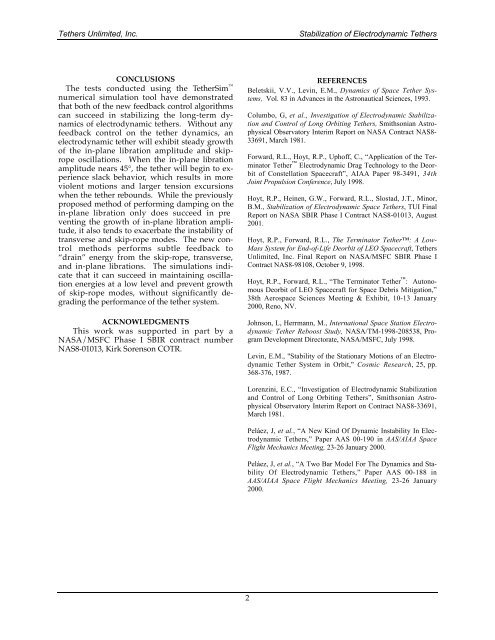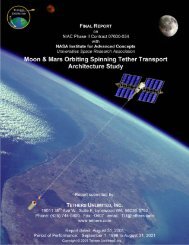STABILIZATION ELECTRODYNAMIC SPACE TETHERS
STABILIZATION OF ELECTRODYNAMIC ... - Tethers Unlimited
STABILIZATION OF ELECTRODYNAMIC ... - Tethers Unlimited
You also want an ePaper? Increase the reach of your titles
YUMPU automatically turns print PDFs into web optimized ePapers that Google loves.
Tethers Unlimited, Inc.Stabilization of Electrodynamic TethersCONCLUSIONSThe tests conducted using the TetherSim numerical simulation tool have demonstratedthat both of the new feedback control algorithmscan succeed in stabilizing the long-term dynamicsof electrodynamic tethers. Without anyfeedback control on the tether dynamics, anelectrodynamic tether will exhibit steady growthof the in-plane libration amplitude and skipropeoscillations. When the in-plane librationamplitude nears 45°, the tether will begin to experienceslack behavior, which results in moreviolent motions and larger tension excursionswhen the tether rebounds. While the previouslyproposed method of performing damping on thein-plane libration only does succeed in preventing the growth of in-plane libration amplitude,it also tends to exacerbate the instability oftransverse and skip-rope modes. The new controlmethods performs subtle feedback to“drain” energy from the skip-rope, transverse,and in-plane librations. The simulations indicatethat it can succeed in maintaining oscillationenergies at a low level and prevent growthof skip-rope modes, without significantly degradingthe performance of the tether system.ACKNOWLEDGMENTSThis work was supported in part by aNASA/MSFC Phase I SBIR contract numberNAS8-01013, Kirk Sorenson COTR.REFERENCESBeletskii, V.V., Levin, E.M., Dynamics of Space Tether Systems,Vol. 83 in Advances in the Astronautical Sciences, 1993.Columbo, G, et al., Investigation of Electrodynamic Stabilizationand Control of Long Orbiting Tethers, Smithsonian AstrophysicalObservatory Interim Report on NASA Contract NAS8-33691, March 1981.Forward, R.L., Hoyt, R.P., Uphoff, C., “Application of the TerminatorTether Electrodynamic Drag Technology to the Deorbitof Constellation Spacecraft”, AIAA Paper 98-3491, 34thJoint Propulsion Conference, July 1998.Hoyt, R.P., Heinen, G.W., Forward, R.L., Slostad, J.T., Minor,B.M., Stabilization of Electrodynamic Space Tethers, TUI FinalReport on NASA SBIR Phase I Contract NAS8-01013, August2001.Hoyt, R.P., Forward, R.L., The Terminator Tether: A Low-Mass System for End-of-Life Deorbit of LEO Spacecraft, TethersUnlimited, Inc. Final Report on NASA/MSFC SBIR Phase IContract NAS8-98108, October 9, 1998.Hoyt, R.P., Forward, R.L., “The Terminator Tether : AutonomousDeorbit of LEO Spacecraft for Space Debris Mitigation,”38th Aerospace Sciences Meeting & Exhibit, 10-13 January2000, Reno, NV.Johnson, L, Herrmann, M., International Space Station ElectrodynamicTether Reboost Study, NASA/TM-1998-208538, ProgramDevelopment Directorate, NASA/MSFC, July 1998.Levin, E.M., "Stability of the Stationary Motions of an ElectrodynamicTether System in Orbit," Cosmic Research, 25, pp.368-376, 1987.Lorenzini, E.C., “Investigation of Electrodynamic Stabilizationand Control of Long Orbiting Tethers”, Smithsonian AstrophysicalObservatory Interim Report on Contract NAS8-33691,March 1981.Peláez, J, et al., “A New Kind Of Dynamic Instability In ElectrodynamicTethers,” Paper AAS 00-190 in AAS/AIAA SpaceFlight Mechanics Meeting, 23-26 January 2000.Peláez, J, et al., “A Two Bar Model For The Dynamics and StabilityOf Electrodynamic Tethers,” Paper AAS 00-188 inAAS/AIAA Space Flight Mechanics Meeting, 23-26 January2000.2









